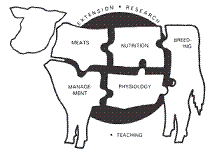Animal Science, Department of
Date of this Version
1-1-1996
Abstract
Wet corn gluten feed (WCGF) is a byproduct of the wet corn milling industry and contains 90 to 110% of the relative energy value of corn in finishing diets. Wet corn gluten feed (Cargill) contains higher levels of protein (20%). phosphorus (1.0%). and potassium (1.2%) than corn. Wet corn gluten feed is higher in lumen degradable (80 vs 40%) and lower in escape protein (20 vs 60%) when compared with corn. The lipid contents of WCGF and corn are similar, at 5%.
Wet distillers byproducts (wet grains and thin stillage) are byproducts of the dry milling industry and have been shown to improve feed efficiency from 2 to 17% when fed at levels of 5.2 to 40% of the diet DM. Due to increased feed efficiency when added to the diet. wet distillers byproducts had a relative energy value of 153% compared to dry rolled corn. Wet distillers byproducts contain 29% crude protein, in which 50% is considered escape protein, and greater than twice the lipid content (12%) found in corn or WCGF.
If ruminal degradable and metabolizable protein requirements of the animal are met, differences in protein supplied should not account for differences in energy estimations between WCGF and wet distillers byproducts. Additional lipid in wet distillers byproducts when compared with WCGF may explain the differences in energy estimations. Therefore, the objectives of this trial were to determine the feeding value of WCGF when fed at different levels in the diet and determine the effect of adding tallow to WCGF finishing diets.


Comments
Published in 1996 Nebraska Beef Cattle Report; published by Agricultural Research Division, Institute of Agriculture and Natural Resources, University of Nebraska-Lincoln.